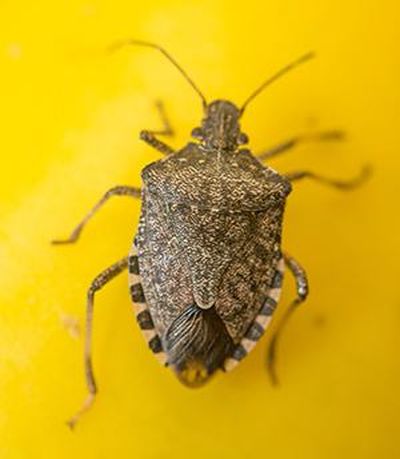Agriculture pest captured in Skagit County for first time

MOUNT VERNON – A brown marmorated stink bug, an agriculture pest that has devastated crops for a decade on the East Coast, has for the first time been captured in Skagit County.
The insect feasts on a variety of crops, including vegetables, fruits and berries. Among its favorites are apples, corn and tomatoes.
It was found Wednesday in a Washington State University Skagit County Extension trap in south Mount Vernon, Director Don McMoran said.
The extension sent a notice Friday to local farmers and gardeners urging them to monitor their fields and report sightings of brown marmorated stink bugs.
McMoran said it will be a few years before the pest could become a serious problem.
“Just because we found one here doesn’t mean there is a reason to get overly excited,” he said. “We just need to continue to monitor it.”
The stink bug, which is about 5/8 of an inch long and 3/8 of an inch wide, harms crops by puncturing them with its needle-like mouth. That puncture causes discoloration and leaves behind bacteria. The pest can cause farmers to lose up to 20 percent of their crops, McMoran said.
Homeowners aren’t exempt from damages either. The pests release pheromones during the winter, causing them to huddle against buildings by the thousands.
Along with their bad smell, they’ll damage trees and home gardens.
Native to Asia, the pest was was first found on the East Coast in 1996. It started causing problems for tree fruit farmers in 2008.
The bug, which spreads quickly by hitching rides on vehicles, migrated to the West Coast and has been moving its way north along Interstate 5.
Though it took about 12 years for the bug to become a real problem on the East Coast, it has caused trouble a lot faster on the West Coast, said WSU Regional Extension Specialist Gwen-Alyn Hoheisel.
It could take three to eight years before it becomes a problem for agriculture, she said.
The bugs reproduce twice a year, laying 20 to 30 eggs on the underside of leaves.
In Washington, the larger stink bug populations are in Vancouver and Walla Walla. Farmers spray affected fields to control the pest in those areas.
For smaller populations of the bug, Hoheisel directs farmers to use traps or other nonspray methods.
Pesticides aren’t always effective against the stink bug because they have hard shells and only their feet touch the plants. Their needle-like mouths can also bypass pesticides.
A native stink bug, called the brown stink bug, looks almost identical to the brown marmorated stink bug. One way to differentiate between the two is to check the bug’s underside. Brown stink bug bellies are a light green, while the bellies of brown marmorated stink bugs are brownish gray.